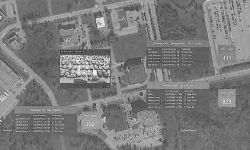Records: MSU shooting lockdown delayed 10 minutes by miscommunication

LANSING — A Michigan State University Police sergeant tried to order a campus lockdown alert just two minutes after a gunman opened fire during a Feb. 13 mass shooting, but the alert was not sent for another 10 minutes, records show.
Authorities have struggled to explain that gap, during which Anthony McRae, 43, walked from Berkey Hall, where he killed two students and shot five, to the MSU Union, where he killed a third student.
Four minutes after that third student — Brian Fraser of Grosse Pointe Park — was fatally shot, MSU finally issued its first “Run. Hide. Fight.” advisory warning students of the active threat.
Police reports released by the university late Thursday shed new light on the delay, suggesting miscommunication between the shift supervisor and a cadet working at the front desk of campus police headquarters.
The records show Sgt. Zachary Rangel radioed “MSU Police Cadets” at approximately 8:20 p.m. to order the campus lockdown alert as he drove out of the parking lot toward Berkey Hall, according to his own account.
But what’s not clear is whether the front desk employee who responded to the radio request understood the directive.
Related:
- MSU shooting 911 calls: McRae spotted in minutes; false tips prolonged ordeal
- Michigan State shooting update: John Hao attends 76ers game as guest of star James Harden
- MSU shooting: Gunman had hundreds of bullets, walked away on busy streets
“Activate the lockdown for the campus,” Rangel said in the radio call, according to an audio recording previously obtained by Bridge Michigan through a Freedom of Information Act request.
After five seconds of silence, Rangel again attempted to reach the desk, but without repeating the lockdown request, at which point an unidentified cadet responded: “Go ahead we got you.”
Rangel thanked the cadet and reiterated his initial order.
“Put the campus in lockdown. Shots fired at Berkey Hall,” he said as he drove to the scene of the initial shooting.
“With this response, it was my belief they copied my previous radio traffic with the order to activate the campus wide alert notification for the shelter in place/ active shooter,” Rangel wrote in a case report narrative four days later.
The alert was sent about 10 minutes later, at 8:30 p.m., according to authorities.
Had it been sent earlier, students and staff in the MSU Union may have been better prepared when McRae entered the building, shot Fraser in a kitchen area off the first-floor cafeteria and walked away at 8:26 p.m.
MSU police did not respond to a request for comment Friday morning, but a spokesperson previously told Bridge that a front-desk employee at police headquarters sent the “pre-scripted” lockdown alert following a request from the shift supervisor.
But with "a lot of radio traffic" that night, the front-desk employee — who is not a police officer and does not usually issue emergency alerts — felt the need to confirm the request with the shift supervisor, Communications Manager Dana Whyte said in March.
It’s not clear when the front desk cadet sought that confirmation. Rangel did not mention it in his case report.
MSU uses student cadets to staff their "central hub" service desk, according to the department's website. In addition to answering phones, they monitor alarm systems and police radio traffic.
The new MSU records also share other details about McRae’s actions leading to the shooting.
A possible motive?
While MSU police have said there is “no conclusive motive” for the shooting, police records indicate a man who identified himself as an acquaintance offered one possible explanation: McRae had said he was “beaten up by students” in downtown East Lansing three weeks before the shooting, according to the reports
Officers investigated the lead and found it to be "not credible," concluding the incident with the students never occurred, police officials told The Detroit News.
Web searches of mass killings
The records show McRae searched or watched videos about the MSU campus, other school shootings, arsons and hypnosis two days before the shooting, according to YouTube search history provided by Google to law enforcement.
McRae also searched “people that shot up colleges” and “mass killings in college” sometime between December 2022 and February 2023.
The reports indicated that McRae bought a pint of blackberry brandy from a convenience store at 2:32 p.m. the day of the shooting, before buying ammunition a few hours later.
Surveillance footage police reviewed showed McRae visited two Dunham’s Sports stores on the afternoon of Feb. 13 and purchased bullets from at least one. He first entered a Dunham's in Lansing's Frandor Shopping Center at 3:38 p.m. and exited eight minutes later. He entered the Dunham's store in the Lansing Mall at 4:48 p.m., where he was filmed buying two boxes of ammunition at 5:02 p.m.
Mall security footage suggests McRae arrived and left by bus.
December web searches
Google data MSU police obtained via warrant shows McRae had used the online search tool to look up Dunham's and a Hi-Point Firearms website several times in late December.
Police have previously said that McRae carried hundreds of bullets and two handguns on the night of the shooting — a Hi-Point C-9 9mm handgun he bought on Sept. 7, 2021, and a Taurus G3 9mm handgun he bought on Oct. 5, 2021.
Investigators believe McRae only used the Taurus, which was loaded with 13 rounds in the magazine and one bullet still in the chamber when officers recovered it, according to police. He also had one extra loaded magazine in the chest pocket of his coat.
The Hi-Point handgun was loaded with nine rounds in a magazine and one bullet in the chamber. Authorities also recovered ten extra Hi-Point magazines in McRae's backpack, along with 136 rounds of loose ammunition.
Michigan Education Watch
Michigan Education Watch is made possible by generous financial support from:
Subscribe to Michigan Education Watch
See what new members are saying about why they donated to Bridge Michigan:
- “In order for this information to be accurate and unbiased it must be underwritten by its readers, not by special interests.” - Larry S.
- “Not many other media sources report on the topics Bridge does.” - Susan B.
- “Your journalism is outstanding and rare these days.” - Mark S.
If you want to ensure the future of nonpartisan, nonprofit Michigan journalism, please become a member today. You, too, will be asked why you donated and maybe we'll feature your quote next time!





